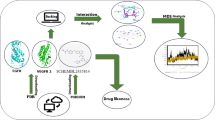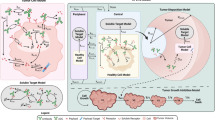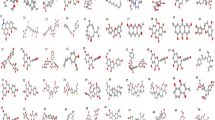Abstract
The most dangerous subtype of breast cancer, triple-negative breast cancer (TNBC), accounts for 25% of all breast cancer-related deaths and 15% of all breast cancer cases. TNBC is distinguished by the lack of immunohistochemical expression of HER2, progesterone receptors, or oestrogen receptors. Although it has been reported that upregulation of EGFR and VEGFR-2 is associated with TNBC progression, no proven effective targeted therapy exists at this time. We used structural bioinformatics methods, including density functional theory, molecular docking, molecular dynamic simulation, pharmacokinetic and drug-likeness models, to identify promising EGFR/VEGFR-2 inhibitors from N-(4-methoxyphenyl)-2-[4-(3-oxo-3-phenylprop-1-en-1-yl) phenoxy] acetamide and six of its modified derivatives in light of the lack of effective targets inhibitor Version 14 of Spartan software was used to analyse density functional theory. The Schrodinger software suite 2018’s Maestro interface was used for the molecular docking analysis, and the admetSAR and swissADME servers were used for drug-likeness and absorption, distribution, metabolism, excretion, and toxicity. All of the compounds showed strong electronic characteristics. Additionally, all of the tested compounds met the ADMET and drug-likeness requirements without a single instance of Lipinski’s rule of five violations. Additionally, the molecules’ levels of affinity for the target proteins varied. The highest binding affinities were demonstrated by the MOLb-VEGFR-2 complex (− 9.925 kcal/mol) and the MOLg-EGFR complex (− 5.032 kcal/mol). The interaction of the molecules in the domain of the EGFR and VEGFR-2 receptors was also better understood through molecular dynamic simulation of the complex.



Similar content being viewed by others
Data availability
The data supporting the findings of this study are available within this article.
References
Jamdade VS, Sethi N, Mundhe NA, Kumar P, Lahkar M, Sinha N (2015) Therapeutic targets of triple-negative breast cancer: a review. Br J Pharmacol 172(17):4228–4237
Reis-Filho J, Tutt A (2008) Triple negative tumours: a critical review. Histopathology 52(1):108–118
Nakai K, Hung MC, Yamaguchi H (2016) A perspective on anti-EGFR therapies targeting triple-negative breast cancer. Am J Cancer Res 6(8):1609
Nascimento C, Gameiro A, Ferreira J, Correia J, Ferreira F (2021) Diagnostic value of VEGF-A, VEGFR-1 and VEGFR-2 in feline mammary carcinoma. Cancers 13(1):117
Neufeld G, Cohen T, Gengrinovitch S, Poltorak Z (1999) Vascular endothelial growth factor (VEGF) and its receptors. FASEB J 13(1):9–22
Hanahan D, Weinberg RA (2011) Hallmarks of cancer: the next generation. Cell 144(5):646–674
Yan JD, Liu Y, Zhang ZY, Liu GY, Xu JH, Liu LY, Hu YM (2015) Expression and prognostic significance of VEGFR-2 in breast cancer. Pathology-Research Practice 211(7):539–543
Mohammed RA, Ellis IO, Mahmmod AM, Hawkes EC, Green AR, Rakha EA, Martin SG (2011) Lymphatic and blood vessels in basal and triple-negative breast cancers: characteristics and prognostic significance. Mod Pathol 24(6):774–785
Martine PA, Melanie DB (2012) Autocrine functions of VEGF in breast tumor cells. Cell Adh Migr 6(6):547–553
Linderholm B, Hellborg H, Johansson U, Elmberger G, Skoog L, Lehtiö J, Lewensohn R (2009) Significantly higher levels of vascular endothelial growth factor (VEGF) and shorter survival times for patients with primary operable triple-negative breast cancer. Ann Oncol 20(10):1639–1646
Sarkar S, Mazumdar A, Dash R, Sarkar D, Fisher PB, Mandal M (2010) ZD6474, a dual tyrosine kinase inhibitor of EGFR and VEGFR-2, inhibits MAPK/ERK and AKT/PI3-K and induces apoptosis in breast cancer cells. Cancer Biol Ther 9(8):592–603
Morgillo F, Cascone T, D'aiuto E, Martinelli E, Troiani T, Saintigny P, . . . Tuccillo, C.: Antitumour efficacy of MEK inhibitors in human lung cancer cells and their derivatives with acquired resistance to different tyrosine kinase inhibitors. British journal of cancer, 105(3): 382–392. (2011)
Rosen AC, Wu S, Damse A, Sherman E, Lacouture ME (2012) Risk of rash in cancer patients treated with vandetanib: systematic review and meta-analysis. J Clin Endocrinol Metab 97:1125–1133
Constantinescu T, Lungu CN. : Anticancer Activity of Natural and Synthetic Chalcones. Int J Mol Sci 22 (21). (2021)
Zhuang C, Zhang W, Sheng C, Zhang W, Xing C, Miao Z (2017) Chalcone: A Privileged Structure in Medicinal Chemistry. Chem Rev 117(12):7762–7810
Salehi B, Quispe C, Chamkhi I, El Omari N, Balahbib A, Sharifi-Rad J, Bouyahya A, Akram M, Iqbal M, Docea AO, Caruntu C, Leyva-Gómez G, Dey A, Martorell M, Calina D, López V, Les F (2020) Pharmacological properties of chalcones: a review of preclinical including molecular mechanisms and clinical evidence. Front Pharmacol 11:592654
Zhang X, Rakesh KP, Bukhari SNA, Balakrishna M, Manukumar HM, Qin HL (2018) Multi-targetable chalcone analogs to treat deadly Alzheimer’s disease: Current view and upcoming advice. Bioorg Chem 80:86–93
Berest GG, Voskoboynik OY, Kovalenko SI, Antypenko OM, Nosulenko IS, Katsev AM, Shandrovskaya OS (2011) Synthesis and biological activity of novel N- cycloalkyl-(cycloalkylaryl)-2-[(3-R-2-oxo-2H-[1,2,4]triazino[2,3-c]quinazoline-6-yl)thio]acetamides. EurJ Med Chem 46(12):6066–6074
Li Z, Wang X, Xu X, Yang J, Qiu Q, Qiang H, Huang W, Qian H (2015) Design, synthesis and structure-activity relationship studies of novel phenoxyacetamide-based free fatty acid receptor 1 agonists for the treatment of type 2 diabetes. Bioorg Med Chem 23(20):6666–6672
Balogun TA, Ipinloju N, Abdullateef OT, Moses SI, Omoboyowa DA, James AC, Saibu OA, Akinyemi WF, Oni EA (2021) computational evaluation of bioactive compounds from Colocasia affinis Schott as novel EGFR inhibitor for cancer treatment. Cancer Inform 20:1–12
Oyeneyin OE, Abayomi T, Ipinloju N, Agbaffa E, Akerele D, Arobadade O (2021) Investigation of amino chalcone derivatives as anti-proliferative agents against MCF-7 breast cancer cell lines-DFT, molecular docking and pharmacokinetics studies. Adv J Chemistry-Section A 4:288–299
Surabhi S, Singh BK (2018) Computer aided drug design: an overview. J Drug Deliv and Ther 8:504–509
Ani FE, Ibeji CU, Obasi NL et al (2021) Crystal, spectroscopic and quantum mechanics studies of Schiff bases derived from 4-nitrocinnamaldehyde. Sci Rep 11:8151
Oyeneyin O, Ipinloju N, Ojo N, Akerele D (2021) Structural modification of ibuprofen as new NSAIDs via DFT, molecular docking and pharmacokinetics studies. JEPS 33:614–626
Oyeneyin OE, Adejoro IA, Obadawo BS, Amoko JS, Kayode IO, Akintemi EO et al (2021) Investigation into the molecular properties of 3-(4-hydroxyphenyl) prop-2-en-1-one 4-phenyl Schiff base and some of its derivatives DFT and molecular docking studies. Sci Lett 9(1):4–11
Kikiowo B, Ogunleye AJ, Inyang OK, Adelakun NS, Omotuyi OI, Metibemu DS, David TI, Oludoyi OO, Ijatuyi TT (2020) Flavones scaffold of Chromolaena odorata as a potential xanthine oxidase inhibitor: induced fit docking and ADME studies. Bioimpacts 10:227–234
Oyeneyin OE, Odadawo SO, Orimoloye SM, Akintemi EO, Ipinloju N, Asere AM, Owolabi TO (2021) Prediction of inhibition activity of BET bromodomain inhibitors using grid search based extreme learning machine and molecular docking. Lett Drug Des Discov 18:1–11
Olanrewaju AA, Ibeji CU, Oyeneyin OE (2020) Biological evaluation and molecular docking of some newly synthesized 3D-series metal(II) mixed-ligand complexes of fluoro-naphthyl diketone and dithiocarbamate. SN Appl Sci 2:678
Nguyen Tien C, Vu Quoc T, Nguyen Dang D, Le Duc G, Van Meervelt L (2021) Synthesis and structure of (E)-N-(4-methoxyphenyl)-2-[4-(3-oxo-3-phenylprop-1-en-1-yl) phenoxy] acetamide. Acta Crystallographica Section E: Crystallogr Commun 77:184–189
Oyeneyin OE, Ojo ND, Ipinloju N, James AC, Agbaffa EB (2022) Investigation of corrosion inhibition potentials of some aminopyridine Schiff bases using density functional theory and Monte Carlo simulation. Chem Africa 5:319–332
Shao Y, Molnar LF, Jung Y. et al. (2014). SPARTAN ‘14, build 1.01. Irvine (CA): Wavefunction Inc.
Becke AD (1993) Density-functional thermochemistry. III. The role of exact exchange. J Chem Phys 98:5648–5652
Jensen F (2001) Polarization consistent basis sets: principles. J Chem Phys 115:9113–9125
Schrödinger L (2018) Schrödinger Release 2018–1: Maestro. New York, NY, USA, Schrödinger LLC
Olsson MH (2011) Protein electrostatics and pKa blind predictions; contribution from empirical predictions of internal ionizable residues. Proteins: Struct Funct Bioinformatics 79:3333–3345
Ibrahim, A., Ipinloju, N., Atasie, N. H., Babalola, R. M., Muhammad, S. A., & Oyeneyin, O. E.: Discovery of small molecule PARKIN activator from antipsychotic/anti-neuropsychiatric drugs as therapeutics for PD: an in silico repurposing approach. Appl Biochem Biotechnol, 1–23. (2023)
Wang JM, Wolf RM, Caldwell JW, Kollman PA, Case D (2004) Development and testing of a general amber force field. J. Comput. Chem 25:1157–1174
Maier JA, Martinez C, Kasavajhala K, Wickstrom L, Hauser KE, Simmerling C (2015) Improving the accuracy of protein side chain and backbone parameters from Ff99SB. J Chem Theory Comput 11:3696–3713
Cornell WD, Cieplak P, Bayly CI, Kollman PA (1993) Application of RESP charges to calculate conformational energies, hydrogen bond energies, and free energies of solvation. J Am Chem Soc 115:9620–9631
Wang JM, Cieplak P, Kollman PA (2000) How well does a restrained electrostatic potential (RESP) model perform in calculating conformational energies of organic and biological. J Comput Chem 21:1049–1074
Frisch MJ, Trucks GW, Schlegel HB, Scuseria GE, Robb MA, Cheeseman JR. Scalmani G, Barone V, Petersson GA, Nakatsuji H, et al (2016) Gaussian 09, Revision A.02
Anandakrishnan R, Aguilar B, Onufriev AV (2012) Automating PK prediction and the preparation of biomolecular structures for atomistic molecular modeling and simulations. Nucleic Acids Res 40:W537–W541
Jorgensen WL, Chandrasekhar J, Madura JD, Impey RW, Klein ML (1983) Comparison of simple potential functions for simulating liquid water. J Chem Phys 79:926–935
Darden T, York D, Pedersen L (1993) Particle Mesh Ewald: An N·log(N) Method for Ewald Sums in Large Systems. J Chem Phys 98:10089–10092
Ryckaert JP, Ciccotti G, Berendsen HJC (1977) Numerical integration of the Cartesian equations of motion of a system with constraints: molecular dynamics of n-alkanes. J Comput Phys 23:327-341.d
Genheden S, Ryde U (2015) The MM/PBSA and MM/GBSA methods to estimate ligand-binding affinities. Expert Opin Drug Discov 10:449–461
Kollman PA, Massova I, Reyes C, Kuhn B, Huo S, Chong L, Lee M, Lee T, Duan Y, Wang W et al (2000) Calculating structures and free energies of complex molecules: combining molecular mechanics and continuum models. Acc Chem Res 33:889–897
Costa RA, da; Rocha JAP, da; Pinheiro AS, Costa A, do S.S. da; Rocha ECM, da; Silva Rai. C, Gonçalves, Ada S, Santos CBR, Brasil D, do S.B.: A computational approach applied to the study of potential allosteric inhibitors protease NS2B/NS3 from Dengue Virus. Molecules 27:4118 (2022)
AL-Makhzumi QMAH, Abdullah HI, AL-Ani RR (2018) Theoretical study of N-methyl-3-phenyl-3-(-4-(trifluoromethyl)phenoxy)propan as a drug and its five derivatives. J Biosci Med 6:80–98
Geerlings P, De Proft F (2002) Chemical reactivity as described by quantum chemical methods. Int J Mol Sci 3:276–309
Chakraborty T, Gazi K, Ghosh DC (2020) Computational of the atomic radii through the conjoint action of the effective nuclear charge and ionization energy. Mol Phys 108(2081):2092
Pearson RG (1963) Hard and soft acids and bases. J Am Chem 85:3533–3539
Nasiri SK, Reisi-Vanani A, Hamadanian M (2018) Molecular structure, spectroscopic, local and global reactivity descriptors and NBO analysis of C32H12: a new buckybowl and sub-fullerene structure, Polycyclic Aromat. Compd 1:1–12
Deghady AM, Hussein RK, Alhamzani AG, Mera A (2021) Density functional theory and molecular docking investigations of the chemical and antibacterial activities for 1-(4-hydroxyphenyl)-3-phenylprop-2-en-1-one. Molecules 26:3631
Choi J, Jung WH, & Koo JS.: Clinicopathologic features of molecular subtypes of triple negative breast cancer based on immunohistochemical markers (2012)
Zhang M, Zhang X, Zhao S, Wang Y, Di W, Zhao G, Zhang Q (2014) Prognostic value of survivin and EGFR protein expression in triple-negative breast cancer (TNBC) patients. Target Oncol 9:349–357
Kumar H, Kumar SR, Kumar NN, Ajith S (2021) Molecular docking studies of gyrase inhibitors: weighing earlier screening bedrock. In Silico Pharmacol 9:1–10
Elekofehinti OO, Iwaloye O, Josiah SS, Lawal AO, Akinjiyan MO, Ariyo EO (2021) Molecular docking studies, molecular dynamics and ADME/tox reveal therapeutic potentials of STOCK1N-69160 against papain-like protease of SARS-CoV-2. Mol Diversity 25:1761–1773
Berest GG, Voskoboynik OY, Kovalenko SI, Antypenko OM, Nosulenko IS, Katsev AM, Shandrovskaya OS (2011) Synthesis and biological activity of novel N cycloalkyl(cycloalkylaryl)-2-[(3-R-2-oxo-2H-[1, 2, 4] triazino [2, 3-c] quinazoline-6-yl) thio] acetamides. Eur J Med Chem 46:6066–6074
Rani P, Pal D, Hegde RR, & Hashim SR (2014) Anticancer, anti-inflammatory, and analgesic activities of synthesized 2-(substituted phenoxy) acetamide derivatives. BioMed Research International
Li Z, Wang X, Xu X, Yang J, Qiu Q, Qiang H, Qian H (2015). Design, synthesis and structure activity relationship studies of novel phenoxyacetamide-based free fatty acid receptor 1 agonists for the treatment of type 2 diabetes. Bioorganic & medicinal chemistry 23(20): 6666–6672 (2015)
Patel V, Shukla M, Bhatt A, Prajapati S (2013) Synthesis, and antimicrobial evaluation of some new acetamide derivatives containing 1, 2, 4-triazole ring. Int J Res Pharm Biomed Sci 4:270–278
Williams JD, Torhan MC, Neelagiri VR, Brown C, Bowlin NO, Di M, Bowlin TL (2015) Synthesis and structure–activity relationships of novel phenoxyacetamide inhibitors of the Pseudomonas aeruginosa type III secretion system (T3SS). Bioorg Med Chem 23:1027–1043
Olubode S, Bankole O, Akinnusi P, Salaudeen W, Ojubola K, Adanlawo O et al (2022) Computational study of the inhibitory potential of Gongronema latifolium (benth) leave on farnesyl pyrophosphate synthase, a target enzyme in the treatment of osteoporosis. A molecular modelling approach. J Herb Drugs 13(2):10
Akinnusi PA, Olubode SO, Salaudeen WA (2022) Molecular binding studies of anthocyanins with multiple antiviral activities against SARS-CoV-2. Bull Natl Res Cent 46(1):102
Olubode SO, Bankole MO, Akinnusi PA, Adanlawo OS, Ojubola KI, Nwankwo DO, et al (2022) Molecular modeling studies of natural inhibitors of androgen signaling in prostate cancer. Cancer Inform
Omoboyowa DA, Balogun TA, Saibu OA, Chukwudozie OS, Alausa A, Olubode SO et al (2022) Structure-based discovery of selective CYP17A1 inhibitors for castration-resistant prostate cancer treatment. Biol Methods Protoc 10:7
Borjian Boroujeni M, Shahbazi Dastjerdeh M, Shokrgozar M, Rahimi H, Omidinia E.(2021) Computational driven molecular dynamics simulation of keratinocyte growth factor behavior at different pH conditions. Informatics in Medicine Unlocked
Benet LZ, Hosey CM, Ursu O, Oprea TI (2016) BDDCS, the Rule of 5 and drugability. Adv Drug Deliv Rev 101:89–98
Sarkar K, Sarkar S, Das RK (2021) Screening of drug efficacy of rosmarinic acid derivatives as aurora kinase inhibitors by computer-aided drug design method. Curr Comput Aided Drug Des 17:627–646
Wanat K (2020) Biological barriers, and the influence of protein binding on the passage of drugs across them. Mol Biol Rep 47:3221–3231
Smith D, Di L, Kerns E (2010) The effect of plasma protein binding on. In Vivo. Walum, E. (1998) Acute oral toxicity. Environ Health Perspect 106:497–503
Mortelmans K (2000) Zeiger EJMrf, mutagenesis mmo. The Ames Salmonella/microsomemutagenicity assay. Mutat Res 455:29–60
Savjani KT, Gajjar AK, Savjani JK (2012) Drug solubility: importance and enhancement techniques. ISRN Pharm 2012:195727
Lamothe SM, Guo J, Li W, Yang T, Zhang S (2016) The human ether-a-go-go related gene (hERG) potassium channel represents an unusual target for protease-mediated damage. J Biol Chem 291:20387–20401
Author information
Authors and Affiliations
Contributions
Conceptualization: N.I and A.I. Introduction and methodology: N.I., A.I., R.A.d.C., A.O.A. and T.B.A. Formal analysis: N.I., A.I., R.A.d.C., T.O.E. and S.O.O. Data curation: N.I., A.I., R.a.d.C., S.O.O. and K.J.A. Writing original draft preparation: N.I., A.I., R.A.d.C., S.O.O. and A.O.A. Writing review and editing: T.O.E., S.A.M. and O.E.O. Supervision: S.A.M. and O.E.O. All authors read and approve the final manuscript.
Corresponding authors
Ethics declarations
Competing interests
The authors declare no competing interests.
Additional information
Publisher's note
Springer Nature remains neutral with regard to jurisdictional claims in published maps and institutional affiliations.
Rights and permissions
Springer Nature or its licensor (e.g. a society or other partner) holds exclusive rights to this article under a publishing agreement with the author(s) or other rightsholder(s); author self-archiving of the accepted manuscript version of this article is solely governed by the terms of such publishing agreement and applicable law.
About this article
Cite this article
Ipinloju, N., Ibrahim, A., da Costa, R.A. et al. Quantum evaluation and therapeutic activity of (E)-N-(4-methoxyphenyl)-2-(4-(3-oxo-3-phenylprop-1-en-1-yl) phenoxy)acetamide and its modified derivatives against EGFR and VEGFR-2 in the treatment of triple-negative cancer via in silico approach. J Mol Model 29, 159 (2023). https://doi.org/10.1007/s00894-023-05543-2
Received:
Accepted:
Published:
DOI: https://doi.org/10.1007/s00894-023-05543-2




